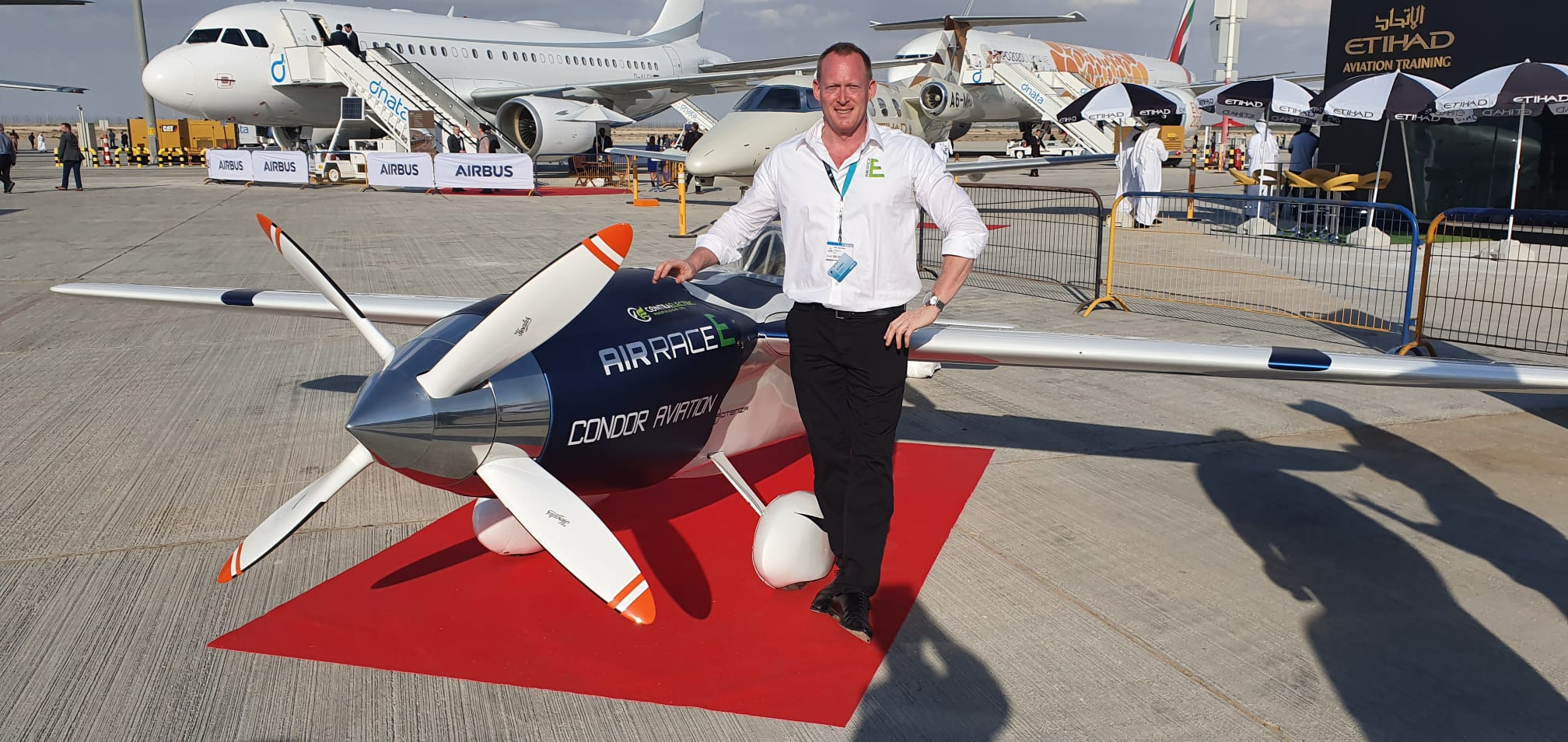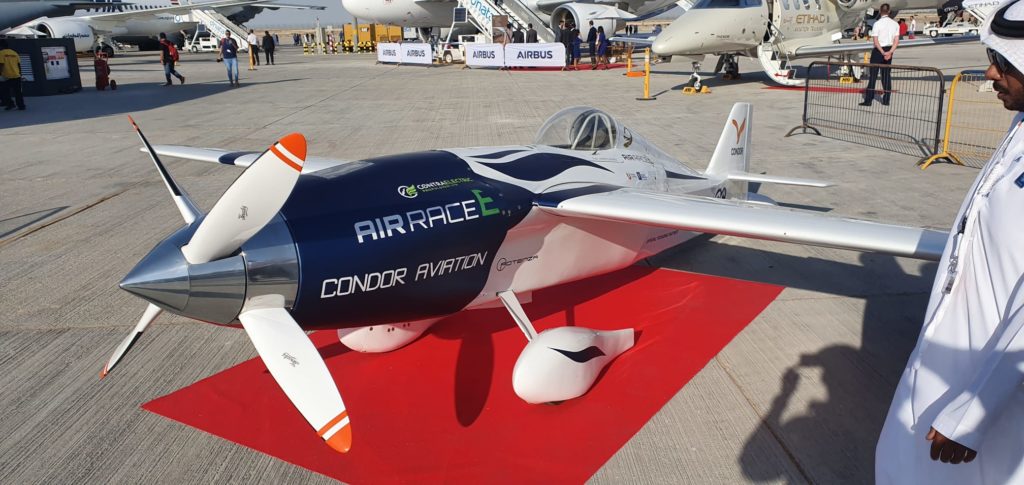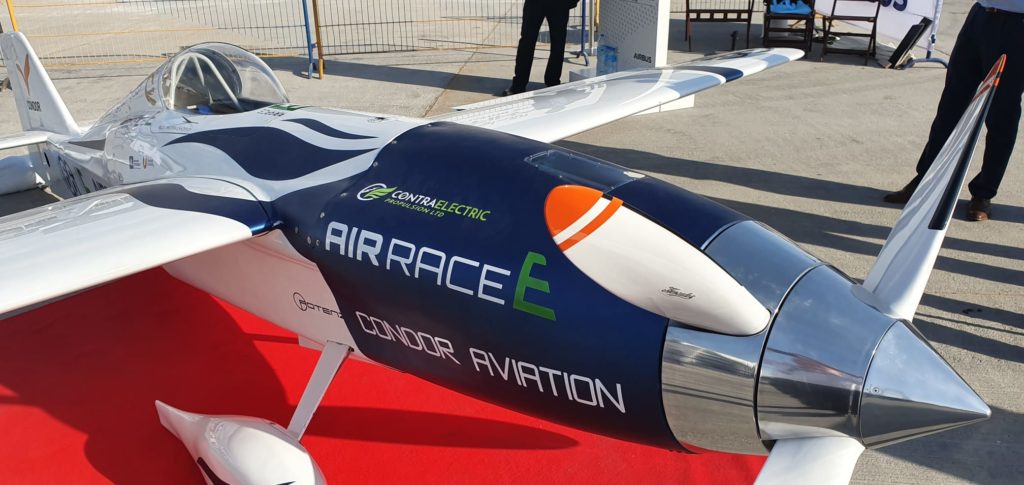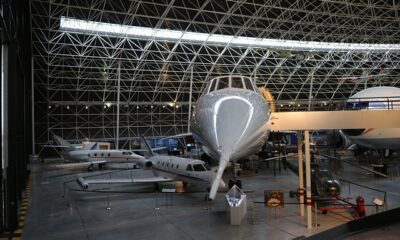Aviation
World’s first electric race plane unveiled at Dubai Airshow

Sunday 17th November, Dubai: The world’s first electric race plane has been unveiled on day one at the Dubai Airshow, showcasing custom modified technology built by one of the racing teams set to take part in the inaugural Air Race E event next year.

Air Race E, a pioneering electric air racing series headed by international air racing promoter Jeff Zaltman, made history when it revealed the plane on display at the airshow, in association with the series’ Official Founding Partner, Airbus.
Speaking at the unveiling, Air Race E CEO and Founder Jeff Zaltman said, “This is a pivotal moment not only for Air Race E, but for the aviation industry as a whole. Our aim by establishing an electric racing series is to develop a unifying platform for the development of cleaner, faster and more technologically advanced electric aircraft. The racing series will provide a testbed for innovation and accelerate the journey towards electric commercial travel. We’ve now shown it is possible and are on track to again create history when planes like the one on display at the Dubai Airshow take to the skies for the race next year.”
The E-Racer Model is the first ever example of an electric race plane, built by Team Condor in their Yorkshire-based workshop in the North of England using a highly-modified Cassutt aircraft with a rich history in formula air racing dating back to 1979.

The custom Cassutt racer named White Lightning was once a regular on the formula one racing circuit in Europe throughout the 80’s and 90’s, with owner and pilot Andrew Chadwick earning a number of podium finishes to add to White Lightning’s racing pedigree. Chadwick has since donated the aircraft to Team Condor to compete in the upcoming Air Race E series.
Team Condor leader Martyn Wiseman and his crew have spent the past months converting White Lightning into a fully-electric racing machine, utilising a Contra Electric twin motor and contra-rotating propeller powertrain.
The customised electric motor will enable the plane to race at speeds of around 300MPH. During the races, the combined max continuous power will be set at 150kW, according to the electric formula. Over 100kg worth of lithium batteries installed under the fuselage of the plane will provide power for five minutes of high intensity racing and around 10 minutes of reserve flying at reduced power.
As Official Founding Partner, Airbus providing teams, including Team Condor, with industry insight and research as they build and modify their racing aircraft.
The E-Racer model on display at the Dubai Airshow, nicknamed White Lightning, is one of two electric race planes nearest to completion, the other is being built at the University of Nottingham’s Aerospace Technology Centre in the UK as part of its £13M Propulsion Futures Beacons of Excellence research programme. Project lead Richard Glassock, a University of Nottingham engineering fellow, has also been instrumental in the development of White Lightning and expects to have his model in the air by early next year.
Air Race E will be a series of head-to-head international air races, showcasing the skills, expertise and ingenuity of the best pilots and engineers from around the world. Unlike similar racing events which operate on a time trial basis, Air Race E events will see eight planes fly simultaneously around a tight 5km circuit at just 10m above the ground and at speeds of up to 450kph – faster than any land-based motorsport.
Air Race E will announce the first eight teams to contest the inaugural race on Tuesday 19th November. The racing field includes strong representation across Europe and North America, with team leaders coming from diverse backgrounds in aerobatics, manufacturing, air racing, the military and robotics.
A tender for the first host city is underway, with the successful bid to be announced in due course. Air Race E remains open for parties to register their interest in entering or sponsoring a team or hosting a future race.
About White Lightning by Team Condor
Power: 150 kW max continuous
Battery: ~20kWh
Aircraft type: Cassutt Racer (modified)
Engine type: Fully electric
Wing span: 4.6m
Length: 4m
Weight: 375kg

Aviation
Exploring the Different Types of Helicopter Rotor Systems and the Science Behind Them

Helicopters are unique aircraft that use rotating blades, called rotors, to generate lift and enable flight. The design of these rotor systems is crucial because it affects how helicopters perform, maneuver, and respond to different flying conditions.
There are several types of helicopter rotor systems, each with its own advantages and specific uses. Understanding these systems helps us appreciate the engineering behind helicopters and their diverse capabilities, from search and rescue missions to military operations and aerial photography.
In this Video, we will explore the main types of helicopter rotor systems and how they contribute to the helicopter’s functionality and performance.
1. Single Rotor System
The single rotor system is characterized by a single main rotor blade that is responsible for generating lift. To counteract the torque produced by this rotor, a tail rotor is used. This setup is essential for maintaining directional control and stability during flight.
Uses: This design is prevalent in most conventional helicopters, including iconic models such as the Bell 206 and the Robinson R22. The simplicity of the single rotor system not only reduces mechanical complexity but also enhances efficiency. As a result, it is favored for a variety of applications, including aerial tours, law enforcement, and emergency medical services, where reliability and straightforward operation are paramount.
2. Tandem Rotor System
The tandem rotor system features two parallel rotors of equal size that rotate in opposite directions. This counter-rotation helps to cancel out the torque that each rotor would otherwise produce, resulting in a balanced and stable flight profile.
Uses: This configuration is typically employed in heavy-lift helicopters, such as the CH-47 Chinook. The tandem design allows for an increased payload capacity and enhanced stability, making it particularly effective for transporting troops, equipment, and supplies in military operations, as well as for civilian applications like logging and construction, where heavy lifting is required.
3. Coaxial Rotor System
The coaxial rotor system consists of two rotors mounted one above the other on the same mast, rotating in opposite directions. This innovative design minimizes the need for a tail rotor, allowing for a more compact helicopter structure.
Uses: Coaxial rotor systems can be found in helicopters such as the Kamov Ka-50. This design offers several advantages, including enhanced lift capabilities, improved maneuverability, and better control in various flight conditions. These features make it particularly suitable for military applications, where agility and quick response times are crucial, as well as for specific civilian operations that require high performance in tight spaces.
4. Intermeshing Rotor System
The intermeshing rotor system consists of two rotors that rotate in opposite directions while intersecting each other, but without colliding. This unique configuration creates a highly efficient aerodynamic profile.
Uses: This system is utilized in helicopters like the Kaman K-MAX, designed specifically for heavy lifting and aerial work. The intermeshing rotors provide remarkable stability and lift capabilities, making it particularly effective for operations in confined spaces, such as urban environments or dense forests. It is ideal for missions that involve heavy external loads, including construction, firefighting, and disaster relief efforts.
5. Transverse rotor system
The transverse rotor system has two parallel rotors that spin in opposite directions, improving lift and stability. This design enhances the aircraft’s aerodynamic efficiency and maneuverability.
A notable example of this system is the V-22 Osprey, a tiltrotor aircraft that merges helicopter vertical lift with the speed of a fixed-wing plane. allowing the Osprey to operate in tough environments like urban areas and remote locations. It can carry heavy loads and personnel, making it suitable for troop transport, search and rescue, medical evacuation, and logistical support in military operations. Overall, the transverse rotor system enhances the V-22 Osprey’s effectiveness and operational flexibility.
6. Compound Rotor System
The compound rotor system combines traditional rotor systems with fixed wings and other aerodynamic features to enhance efficiency and speed. This hybrid approach allows for greater aerodynamic performance than standard rotorcraft.
Uses: Advanced helicopters like the Sikorsky X2 and Boeing’s DBF (Defiant) utilize the compound rotor system. These helicopters are designed for higher speeds and longer ranges, making them suitable for military operations, search-and-rescue missions, and law enforcement tasks where rapid response and extended operational capabilities are essential.
7. NOTAR system
NOTAR system replaces the traditional tail rotor with a ducted fan and directional airflow to counter the torque from the main rotor. It works by pushing air through the tail boom and out through side vents, creating thrust that stabilizes the helicopter. This design reduces noise, boosts safety, and cuts down on maintenance.
Uses: The NOTAR system is found in helicopters like the MD 520N and MD 902 Explorer. Without an exposed tail rotor, it lowers the risk of rotor strikes, making it safer for operations in tight spaces. Its quieter performance is ideal for missions where low noise is needed, such as urban air operations, police work, and medical evacuations.
-

 Aviation2 months ago
Aviation2 months agoNew EU Carry-On Rules Begin September 2024: What to Expect
-

 Aviation2 months ago
Aviation2 months agoBoeing confirms 797: A New Era for Mid-Size Aircraft
-

 Aviation2 months ago
Aviation2 months agoLockheed and Tata Team Up to Build C-130J MRO Facility in India
-

 Aviation1 month ago
Aviation1 month agoMicrosoft Flight Simulator Raises $3 Million to Bring Back the An-225 Mriya
-

 Tech2 months ago
Tech2 months agoChina Developing Jet to Travel Anywhere in Two Hours
-

 Airlines2 months ago
Airlines2 months agoQantas Engineers Stage Walkout Over Cost of Living Concerns
-

 Aviation2 months ago
Aviation2 months agoBoeing Offers 25% Pay Increase & Promise to Build Next Plane in Seattle
-

 Airlines1 month ago
Airlines1 month agoQatar Citizens Can Travel to the United States Without a Visa








